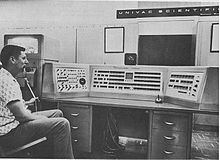UNIVAC 1101
This article needs additional citations for verification. (January 2013) |
 UNIVAC 1101 | |
| Also known as | ERA 1101 |
|---|---|
| Developer | Engineering Research Associates (ERA) |
| Manufacturer | Engineering Research Associates |
| Release date | 1950 |
| Dimensions | 38 ft (12 m) long, 20 ft (6.1 m) wide |
| Mass | 8.4 short tons (7.6 t) |
| Successor | UNIVAC 1103 |
The ERA 1101, later renamed UNIVAC 1101, was a computer system designed and built by Engineering Research Associates (ERA) in the early 1950s and continued to be sold by the Remington Rand corporation after that company later purchased ERA. Its (initial) military model, the ERA Atlas, was the first stored-program computer that was moved from its site of manufacture and successfully installed at a distant site. Remington Rand used the 1101's architecture as the basis for a series of machines into the 1960s.
History
Codebreaking
ERA was formed from a group of code-breakers working for the
After the war, the team continued to build codebreaking machines, targeted at specific codes. After one of these codes changed, making an expensive computer obsolete, the team convinced the Navy that the only way to make a system that would remain useful was to build a fully programmable computer. The Navy agreed, and in 1947 they funded development of a new system under "Task 13".
The resulting machines, known as "Atlas", used
Commercialization
The company turned to the task of selling the systems commercially. Atlas was named after a character in the popular comic strip
At about this time the company became embroiled in a lengthy series of political maneuverings in Washington, D.C. Drew Pearson's Washington Merry-Go-Round claimed that the founding of ERA was a conflict of interest for Norris and Engstrom because they had used their war-time government connections to set up a company for their own profit. The resulting legal fight left the company drained, both financially and emotionally. In 1952 they were purchased by Remington Rand, largely as a result of these problems.
Remington Rand had recently purchased
Description

This computer was 38 ft (12 m) long, 20 ft (6.1 m) wide, weighed about 8.4 short tons (7.6 t)
The single 48-bit accumulator was fundamentally subtractive, addition being carried out by subtracting the ones' complement of the number to be added. This may appear rather strange, but the subtractive adder reduces the chance of getting negative zero in normal operations.
The machine had 38 instructions.
Instruction set
- Conventions
- y is memory box at address y
- X = X-Register (24 bits)
- ( ) is interpreted as the contents of
- Q = Q-Register (24 bits)
- A = Accumulator (48 bits)
- Arithmetic
- Insert (y) in A
- Insert complement of (y) in A
- Insert (y) in A [multiple precision]
- Insert complement of (y) in A [multiple precision]
- Insert absolute value (y) in A
- Insert complement of absolute value (y) in A
- Add (y) to (A)
- Subtract (y) from (A)
- Add (y) to (A) [multiple precision]
- Subtract (y) from (A) [multiple precision]
- Add absolute value of (y) to (A)
- Subtract absolute value of (y) from (A)
- Insert (Q) in A
- Clear right half of A
- Add (Q) to (A)
- Transmit (A) to Q
- Insert [(y) + 1] in A
- Multiply and divide
- Form product (Q) * (y) in A
- Add logical product (Q) * (y) to (A)
- Form logical product (Q) * (y) in A
- Divide (A) by (y), (quotient forms in Q, non-negative remainder left in A)
- Add product (Q) * (y) to (A)
- Logical and control flow
- Store right half of (A) at y
- Shift (A) left
- Store (Q) at y
- Shift (Q) left
- Replace (y) with (A) using (Q) as operator
- Take (y) as next order
- Replace (y) with (A) [address portion only]
- Take (y) as next order if (A) is not zero
- Insert (y) in Q
- Take (y) as next order if (A) is negative
- Take (y) as next order if (Q) is negative
- Input Output and control
- Print right-hand 6 digits of (y)
- Optional Stop
- Print and punch right-hand 6 digits of (y)
- Intermediate Stop
- Final Stop
See also
References
- ]
- ^ "1. The ERA 1101 Computer". Digital Computer Newsletter. 3 (1): 1, 2. April 1951.
- ^ ISBN 9780471472209.
- ^ "Characters: Barnaby, page 1". Crockett Johnson Home Page. Atlas. Archived from the original on 2013-02-24. Retrieved 2003-05-06.
- ISBN 9780262161473.
- ISBN 978-0815707219.
- ^ Weik, Martin H. (December 1955). "UNIVAC-SCI (ERA-1101)". ed-thelen.org. A Survey of Domestic Electronic Digital Computing Systems.
- ^ (16,000 lbs + 17,400 lbs ) / 2 = 16,700 pounds (8.4 short tons)
16,000 pounds (8.0 short tons; 7.3 t)
17,400 pounds (8.7 short tons; 7.9 t) - ISSN 0025-5718.
External links
- Engineering Research Associates and the Atlas Computer (UNIVAC 1101) - Unisys History Newsletter, Volume 3, Number 3 at the Wayback Machine (archived September 13, 2017)
- Introducing the ERA 1101: An operationally proven high-speed, electronic, general purpose digital computer, ERA, no-date. (8 pp) [1]
- Oral history interviews with ERA personnel on 1101, Charles Babbage Institute, University of Minnesota. Interviewees include Arnold A. Cohen; Arnold Dumey [2]; John Lindsay Hill; Frank Mullaney; and William C. Norris [3].
- ERA 1101 Documents (archive) list of 44 scanned course notes on 1101 by H. C. Snyder USN
- Summary of Characteristics Magnetic Drum Binary Computer, Engineering Research Associates Pub No. 25, 30 November 1948
